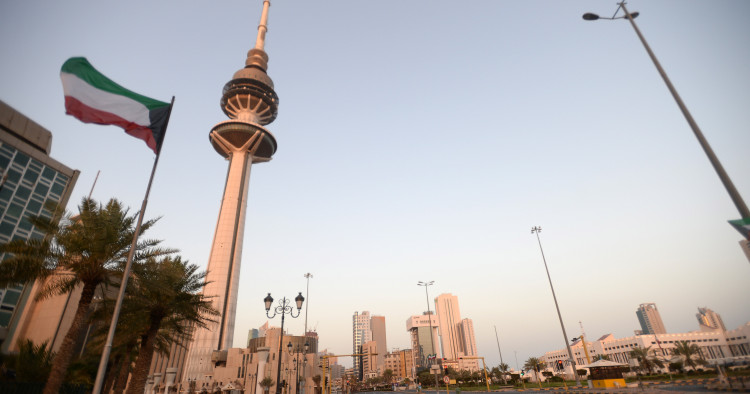Kuwait is stuck in a major predicament. The government continues to engage in significant deficit spending, even as it's readily available funds dwindle, while political gridlock limits the government’s ability to replace those shrinking financial resources.
Fiscal strengths
Although Kuwait is dealing with liquidity challenges, it is flush with financial reserves. As of January 2021, it was producing 2.3 million barrels of oil per day, making it the tenth largest producer in the world. GDP per capita in 2019 was $32,000, among the highest in the Middle East and North Africa. The country’s Reserve Fund for Future Generations (RFFG) is reported to
Short-term financial pressures
However, there are serious concerns that the government won’t be able to make
Kuwait does have the financial resources to tackle its immediate budget issues. The solution is for the National Assembly to issue a law that would allow the government to tap international debt markets or to withdraw funds from the RFFG. However, to date Parliament has been unwilling to take these actions amid strong disagreements over broader governance issues with the executive branch.
More specifically, the National Assembly has been unwilling to pass legislation to raise money without getting something in return. It wants the government to root out corruption, waste, and mismanagement, which MPs have suggested are the real reason for the country’s fiscal woes
Nevertheless, Kuwait will find a way to avoid a major fiscal crisis
Bigger issues on the horizon
While debt issuances or withdrawal of RFFG funds would help to solve Kuwait’s fiscal issues for the next year or two, the bigger issue is the need to enact deeper structural reforms to
At the crux of this is the public sector wage bill. According to an IMF study from 2015, the government employs more than 85% of the national workforce, resulting in the GCC’s highest public sector wage bill at 12.4% of GDP. The use of government jobs to maintain low unemployment rates is unsustainable due to Kuwait’s youth bulge, which will see its largest demographic groups enter the workforce in the coming years. As of 2020, Kuwait’s largest population groups, by five-year increments, were those aged 5-9 years, 10-14 years, 1-4 years, and then 15-19 years. The country already has high youth unemployment at 16.5%, and UNICEF estimates that by 2030 Kuwait will face a 53% increase in youth labor force compared to 2015. There will be significant public pressure on the government to provide jobs for young citizens.
The government in 2018 sought to address this systemic issue by announcing a new Kuwaitization program, which would reduce employment of foreigners in the public sector in an attempt to make room for young Kuwaitis. According to government statistics in 2018, 25% of the government’s 400,000 employees were expatriates. However, this process will present its own challenges. The largest concentrations of foreigners are in the Ministry of Education and Ministry of Public Health, positions that entail specific
All of this is to say that ever-growing salaries and pensions will continue to take up a significant percentage of government spending (72% in the 2021/22 draft budget), which will seriously undermine the state’s ability to direct spending toward capital investments. These investments are needed to create private sector jobs for a growing population, and failure to change government spending habits will sustain the citizenry’s reliance on oil exports that fund state spending.
Looking ahead
Solving this challenge will require buy-in from, and cooperation by, all branches of the government. However, the contentious relationship between the legislative and executive branches and parliamentarians’ strong resistance to public sector employment reform efforts will hinder progress. There is a perception in Parliament that ending government corruption and the eventual return of high oil prices (a sentiment that may be strengthened by the recent oil price rally) would — on its own — bridge the budget gap over the long term. There will also be public resistance to government employment reform that runs counter to Article 41 of the constitution, which mandates that the “state shall make work available to citizens.”
Therefore, once Kuwait solves this immediate fiscal liquidity issue, it will still have large, structural financial and economic challenges over the coming decade that will be very difficult to solve. Nevertheless, failure to do so risks draining the wealth Kuwait has so meticulously and presciently built up since 1953 when it established the world’s first sovereign wealth fund.
Alexander Werman is a political and security risk analyst focusing on the Middle East and North Africa region. In his current role at Control Risks, a global specialist risk consultancy, he leads the company’s research on Jordan, Israel, and the Palestinian Territories. The views expressed in this piece are his own.
Photo by Asad/Xinhua via Getty) (Xinhua/Asad via Getty Images
The Middle East Institute (MEI) is an independent, non-partisan, non-for-profit, educational organization. It does not engage in advocacy and its scholars’ opinions are their own. MEI welcomes financial donations, but retains sole editorial control over its work and its publications reflect only the authors’ views. For a listing of MEI donors, please click here.













